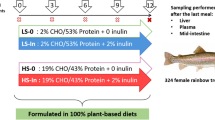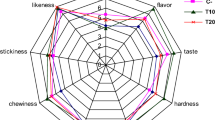Abstract
The effect of taurine supplementation of fishmeal-based feeds for juvenile European sea bass (Dicentrarchus labrax) was investigated. Fish (initial weight ca. 5 g) were reared for 90 days in 12 concrete tanks (1 m3), with 50 fish in each tank. Four feeds (44% crude protein (CP) and 17% lipids (L)) containing 0 (control (CTRL)), 0.4 (T4), 0.7 (T7) and 1.0 (T10) % taurine were prepared and were fed to apparent visual satiation to triplicate groups of fish. The effects on fish growth, feed utilization, proximate chemical composition, haematology, immune biomarkers and muscle morphometry were examined. An increase in the dietary taurine incorporation resulted in progressive increases in the growth metrics, with the highest values being observed for fish receiving the T10 feed (weight gain 22 vs 18 g/fish in CTRL; protein productive value 31 vs 28% in CTRL). Taurine addition at all levels significantly increased the fish protein percentage, but the percentage lipid was reduced significantly in T4 fish only (7.8% compared with 9.4% in CTRL fish). Taurine supplementation resulted in elevated blood lymphocyte and monocyte counts and increased serum phagocytic and lysozyme activities. Taurine addition at 1% (T10 feed), the suggested level to boost growth, altered the dorsal muscle cellularity and myofibril ultrastructure, suggesting enhanced muscle function and firmness in comparison with that of the fish given the CTRL feed.



Similar content being viewed by others
Abbreviations
- CTRL:
-
Control
- T4:
-
4 g taurine/kg diet (0.4%)
- T7:
-
7 g taurine/kg diet (0.7%)
- T10:
-
10 g taurine/kg diet (1%)
- TEM:
-
Transmission electron microscopy
References
Abdel I, López-Albors O, Ayala MD et al (2005) Muscle cellularity at cranial and caudal levels of the trunk musculature of commercial size sea bass, Dicentrarchus labrax (Linnaeus, 1758). Anat Histol Embryol J 34:280–285
Abdel-Mohsen HH, Wassef EA, El-Bermawy NM et al (2018) Advantageous effects of dietary butyrate on growth, immunity competence, intestinal microbiota and histomorphology of European seabass (Dicentrarchus labrax) fry. Egypt J Aquat Biol Fish 22:93–110
AOAC (2005) Official methods of analysis, 16th edn. Association of Official Analytical Chemists, Washington
Ayala MD, López-Albors O, García-Alcázar A et al (2003) Effect of two thermal regimes on the muscle growth dynamics of seabass, Dicentrarchus labrax L. Anat Histol Embryol J 32:271–275
Barral JM, Epstein HF (1999) Protein machines and self-assembly in muscle organization. Bioassay 10:812–823
Bouckenooghe T, Remacle C, Reusens B (2006) Is taurine a functional nutrient? Curr Opin Clin Nutr Metab Care 9:728–733
Buscaino G, Filiciotto F, Buffa G, Bellante A, Stefano VD, Assenza A, Fazio F, Caola G, Mazzola S (2010) Impact of an acoustic stimulus on the motility and blood parameters of European sea bass (Dicentrarchus labrax L.) and gilthead sea bream (Sparus aurata L.). Mar Environ Res 69:136–142
Douglass JW, Jane KW (2010) Schalm’s veterinary hematology. Wiley-Blackwell, London, Hoboken
Doumas B, Bayse D, Carter R et al (1981) A candidate reference method for determination of total protein in serum. I. Development and validation. Clin Chem 27:1642–1650
Ellis AE (1990) Lysozyme assays. In: Stolen JS, Fletcher TC, Anderson DP, Roberson BS, Van Muiswinkel WB (eds) Techniques in fish immunology. SOS Publications, Fair Haven, Fair Haven, pp 101–103
El-Sayed AM (2014) Is dietary taurine supplementation beneficial for farmed fish and shrimp? A comprehensive review. Rev Aquac 6:241–255
Espe M, Ruohonen K, El-Mowafi A (2012) Effect of taurine supplementation on the metabolism and body lipid to protein ratio in juvenile Atlantic salmon (Salmo salar). Aquac Res 43:349–360
Fazio F, Marafioti S, Arfuso F, Piccione G, Faggio C (2013) Comparative study of the biochemical and haematological parameters of four wild Tyrrhenian fish species. Vet Med 58:576–581
Feidantsis K, Kaitetzidou E, Mavrogiannis N, Michaelidis B, Kotzamanis Y, Antonopoulou E (2014) Effect of taurine-enriched diets on the Hsp expression, MAPK activation and the antioxidant defence of the European seabass (Dicentrarchus labrax). Aquac Nutr 20:431–442
Grigorakis K (2007) Compositional and organoleptic quality of farmed and wild gilthead sea bream (Sparus aurata) and sea bass (Dicentrarchus labrax) and factors affecting it: a review. Aquaculture 272:55–75
Hoseini SM, Hosseini SA, Eskandari S, Amirahmadi M, Soudagar M (2017) The effect of dietary taurine on growth performance and liver histopathology in Persian sturgeon, Acipenser persicus (Borodin, 1897) fed plant–based diet. Aquac Res 48:4184–4196
Hurling R, Rodell JB, Hunt HD (1996) Fiber diameter and fish texture. J Texture Stud 27:679–685
Huxtable RJ (1992) Physiological actions of taurine. Physiol Rev 72:101–163
Johnston IA (1999) Muscle development and growth: potential implications for flesh quality in fish. Aquaculture 177:99–115
Kato K, Yamamoto M, Peerapon K et al (2014) Effects of dietary taurine levels on epidermal thickness and scale loss in red sea bream, Pagrus major. Aquac Res 45:1818–1824
Kawahara E, Ueda T, Nomura S (1991) In vitro phagocytic activity of white spotted shark cells after injection with Aeromonas salmonicida extracellular products. Fish Pathology 26:213–214
Kotzamanis Y P, Karacostas I, Grigorakis K et al (2012) Taurine supplementation of low fish meal diets improves growth performance and quality of European sea bass (Dicentrarchus labrax). World Aquaculture Society Meeting, Prague, Czech Republic, 1–5 September, p134
Kousoulaki K, Saether B-S, Albrektsen S, Noble C (2015) Review on European sea bass (Dicentrarchus labrax, Linnaeus, 1758) nutrition and feed management: a practical guide for optimizing feed formulation and farming protocols. Aquac Nutr 21:129–151
López LM, Flores-Ibarra M, Banuelos-Vargas I et al (2015) Effect of fishmeal replacement by soy protein concentrate with taurine supplementation on growth performance, hematological and biochemical status, and liver histology of totoaba juveniles (Totoaba macdonaldi). Fish Physiol Biochem 41:921–936
Martinez J, Chatzifotis S, Divanach P et al (2004) Effect of dietary taurine supplementation on growth performance and feed selection of sea bass, Dicentrarchus labrax, fry fed with demand-feeders. Fish Sci 70:74–79
McCarthy K, Hischenhuber C, Joyce N (2000) Determination of total taurine in pet foods by liquid chromatography of the dansyl derivative: collaborative study. J AOAC Int 83:784–788
NRC (1993) Nutrient requirements of warm water fishes and shellfishes. National Academy Press, Washington
Periago MJ, Ayala MD, Lopez-Albors LO et al (2005) Muscle cellularity and flesh quality of wild and farmed sea bass, Dicentrarchus labrax L. Aquaculture 249:175–188
Qi G, Ai Q, Mai K et al (2012) Effects of dietary taurine supplementation to a casein-based diet on growth performance and taurine distribution in two sizes of juvenile turbot (Scophthalmus maximus L.). Aquaculture 358–359:122–128
Rimoldi S, Finzi G, Terova G et al (2016) Butyrate and taurine exert a mitigating effect on the inflamed distal intestine of European sea bass fed with a high percentage of soybean meal. Fish Aquaculture Sci 19(40):1–14
Roncarati A, Melotti P, Dees A, Mordenti O, Angellotti L (2006) Welfare status of cultured seabass (Dicentrarchus labrax L.) and seabream (Sparus aurata L.) assessed by blood parameters and tissue characteristics. J Appl Ichthyol 22:225–234
Salze GP, Davis DA (2015) Taurine: a critical nutrient for future fish feeds. Aquaculture 437:215–229
SAS (ed) (2004) SAS/STAT software 9, 1st edn. SAS Institute Inc., Cary
Satriyo TB, Galaviz MA, Salze G, López LM (2017) Assessment of dietary taurine essentiality on the physiological state of juvenile Totoaba macdonaldi. Aquac Res 48:5677–5689
Simpson RJ, Neuberger MR, Liu TY (1976) Complete amino acid analysis of proteins from a single hydrolysate. J Biol Chem 25:1936–1940
Türkmen S, Eroldoğan OT, Yilmaz HA et al (2012) Compensatory growth response of European sea bass (Dicentrarchus labrax L.) under cycled starvation and restricted feeding rate. Aquac Res 43:1643–1650
Villegas G, Mulero V (2015) Current knowledge on the development and functionality of immune responses in the European seabass (Dicentrarchus labrax). In: Vazquez F, Muñoz-Cueto J (eds) Biology of European seabass. CRC Press, Taylor and Francis, UK, pp 342–373
Wassef EA, Abdel-Momen SA, Saleh NE et al (2017) Is sodium diformate a beneficial feed supplement for European seabass (Dicentrarchus labrax)? Effect on growth performance and health status. Egypt J Aquat Res 43:229–234
Author information
Authors and Affiliations
Corresponding author
Ethics declarations
Conflict of interest
The authors declare that they have no conflict of interest.
Ethical approval
All applicable international, national, and/or institutional guidelines for the care and use of animals were followed by the authors.
Additional information
Publisher’s note
Springer Nature remains neutral with regard to jurisdictional claims in published maps and institutional affiliations.
Rights and permissions
About this article
Cite this article
Saleh, N.E., Wassef, E.A. & Ashry, A.M. Is a taurine supplement necessary in fishmeal-based feeds for juvenile European sea bass (Dicentrarchus labrax)?. Aquacult Int 28, 321–333 (2020). https://doi.org/10.1007/s10499-019-00464-5
Received:
Accepted:
Published:
Issue Date:
DOI: https://doi.org/10.1007/s10499-019-00464-5




